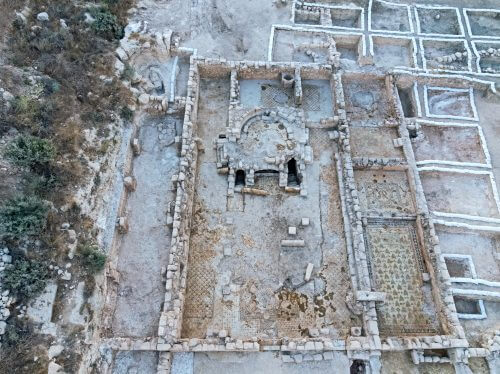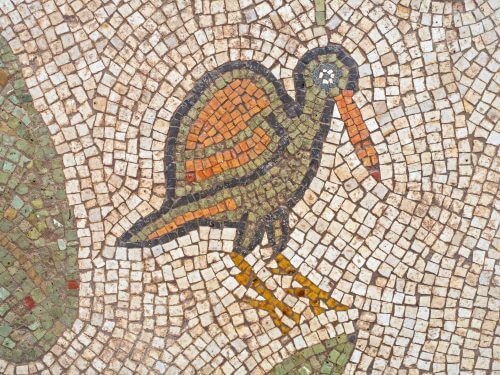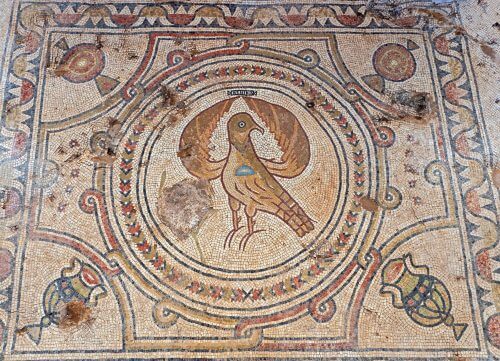A mosaic inscription that was discovered on the site mentions a "glorious martyr" in whose honor the church was built *An inscription on behalf of the emperor Tiberius II was incorporated into the mosaic floors *In the excavations a unique baptismal basin in the shape of a cross was revealed *The large archaeological excavation of the Antiquities Authority took place as part of the expansion of the city of Beit Shemesh in the new neighborhood Neve Shamir 2, under the initiative Ministry of Construction and Housing, and thousands of youth from all over the country participated



Who was the "glorious martyr" commemorated in the Greek inscription, in whose memory a large and magnificent church was built - one that was expanded with the financing of the emperor of the Byzantine Empire, Tiberius II, himself? This mysterious mystery preoccupies the archaeologists at the Antiquities Authority, who have been conducting an archaeological excavation in the Ramat Beit Shemesh neighborhood for the past three years, with the participation of thousands of teenagers, funded by the Jerusalem District Ministry of Construction and Housing and managed by the CPM Group. The Ministry of Construction and Housing invested approximately NIS 70 million in excavations, preservation and development of archaeological parks as part of the construction of the new neighborhood, of which approximately NIS 7 million was allocated to this excavation.
Yesterday (Wed), the findings were revealed to the public as part of the new exhibition "The Glorious Martyr", the result of a collaboration between the Antiquities Authority and the Museum of the Biblical Lands Jerusalem. In the archaeological excavations, the remains of a spacious and magnificent Byzantine church, which was founded on the spot about 1,500 years ago, were uncovered. The church is decorated with magnificent mosaic floors, rich in patterns of leaves, fruits and birds, and geometric patterns. The walls of the church were covered with colorful murals, and in the space of the building columns with impressive titles were integrated; Some are made of imported marble.
The excavations revealed a complex architectural complex with an area of about 1.5 dunams. In the center of the area, a church structure was revealed in the pattern of a basilica - an elongated structure, along which stood two parallel columns of columns that divided it into three; A central middle hall and two halls on its sides. In front of the front of the church stretches a spacious yard (atrium).
The main construction phase of the church was in the days of Emperor Justinianus in the 6th century AD (527-565 AD).
Later, during the reign of Tiberius II Constantine, a magnificent side chapel was added to the church. An intriguing inscription that was uncovered in its entirety in the churchyard attributes the place to a "glorious martyr".
According to Benjamin Storchan, the director of the excavation on behalf of the Antiquities Authority, the identity of the martyr is unknown to us, but the extraordinary beauty of the building and the inscriptions discovered in it indicate that this is an important figure. Storchen adds that "a few churches have been discovered in the country that have a crypt that has survived in its entirety. The crypt is an underground space where, apparently, the remains (relics) of the saint were kept. Two parallel staircases led to the crypt - from one they went down to the underground space, and from the other they went back up to the prayer hall. In this way, large groups of Christian pilgrims could visit the place." The walls of the crypt were covered with marble slabs that gave it a magnificent appearance.
Expansion financed by the Byzantine emperor
According to Storchen, the importance of the site is reconfirmed in light of the expansion carried out under the auspices of Emperor Tiberius II Constantine (574-582 AD). The financing of the expansion by the emperor and under his patronage is documented in a Greek inscription revealed on the site. "Many written sources attest to imperial funding of churches in the Land of Israel, but in archaeological research very few inscriptions such as the one found in Ramat Beit Shemesh are known," says Storchen. "The imperial involvement in the expansion of the building is also reflected in the form of a large eagle with spread wings - a symbol of the Byzantine Empire, which appears on one of the mosaics."
The archaeological excavations at the site were based, in the vast majority, on the work of thousands of youth, who participated in the project as part of the educational vision of the Antiquities Authority, which seeks to connect the youth to the heritage that belonged to them. Among other things, students from preparatory and service years, teenagers from Beit Shemesh and the area, excavators, students of AI and archeology majors who came to dig as part of their matriculation studies, and high school students who came to finance the trip to Poland, excavated at the site. All participants had a special experience of getting to know the country's rich past, teamwork, and rewarding physical effort. In fact, most of the finds in the excavation were discovered by the youth, who learned the proverb "you have touched and found - believe" the first time.
The excavations revealed thousands of objects, and what appears to be the most complete collection of Byzantine glass windows and lamps that has so far been found at a single site in Israel. In addition, in one of the rooms of the church, a one-of-a-kind baptismal basin in the shape of a cross was discovered, which was created from calcite stone, which is formed in stalactite caves.
Amanda Weiss, Director of the Bible Lands Museum: The vision of the Bible Lands Museum is to be a cultural, educational and experiential center that connects those who come through its gates to the roots of the past. We are happy about the cooperation with the Antiquities Authority that allows us to present the impressive finds that were uncovered in the Church of the Magnificent Martyr with the help of thousands of volunteers and the youth. And in the words of the museum's founder, Dr. Eli Borovsky: "The future of humanity is drawn from the roots of the past, only if we understand our history can we build a better future."
